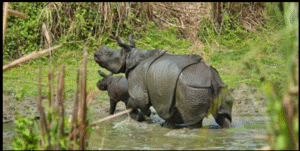
Context:
-
2,573 rhino horn samples that were preserved prior to their destruction in 2021 are being subjected to genetic analysis by the Assam Forest Department in collaboration with the Wildlife Institute of India (WII).
-
In order to support conservation and anti-poaching initiatives, this action will contribute to the development of India’s Rhino DNA Index System (RhoDIS).
About Rhino Horn:
-
The most characteristic feature of a rhinoceros is its horn, which is composed of keratin, the same protein found in human hair and nails, rather than bone.
-
The horns of rhinos grow continuously, gaining roughly 2 cm annually.
-
Important attributes:
-
-
Solid Structure: Made of compacted keratin layers, rhino horns are not hollow like antlers.
-
Melanin and calcium are found in the toughened core, which increases strength and resistance to UV rays.
-
Shape Formation: Its cone-like shape is progressively formed by external behaviours such as grazing, scraping, and exposure to the environment.
-
Identification Tool: Under RhoDIS, each horn’s distinct keratin layers—which are influenced by climate and diet—help with genetic fingerprinting.
-
Threat of Poaching: Because of erroneous medical beliefs, rhino horns are highly prized in the illegal wildlife trade.
-
About Greater One-Horned Rhinoceros:
-
The largest of the five rhino species, it is also referred to as the Indian rhinoceros (Rhinoceros unicornis). It can only be found in South Asia, primarily in Nepal and northeastern India.
-
Habitat & Distribution: Found in savannas, riverine floodplains, and tropical and subtropical grasslands.
-
Principal bastions: Chitwan (Nepal), Jaldapara (West Bengal), and Kaziranga National Park (Assam).
-
IUCN Red List: At risk
-
Unique Qualities:
-
-
One distinctive feature is the single black horn, which measures 8 to 25 inches.
-
Thick grey-brown hide with folded skin plates gives off an armoured appearance.
-
-
Herbivorous: Consumes fruits, shrubs, aquatic plants, and grasses.
-
Semi-Solitary: Aside from times when they graze or mope.
-
Wetland ecosystems are shaped by this keystone grazer.




